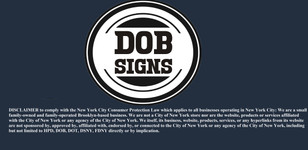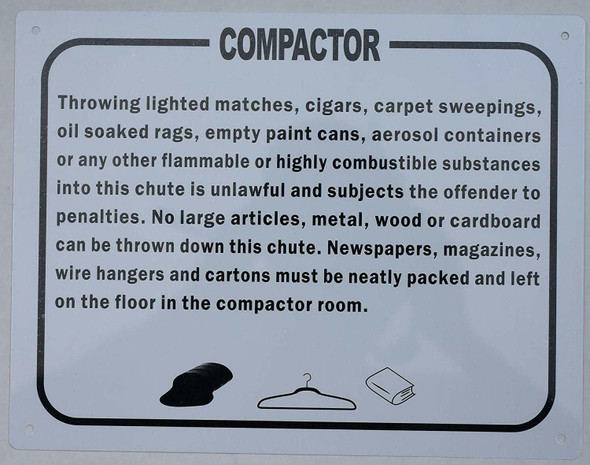BUILDINGSIGNS.COM
Compactor Rules Sign (Silver,Aluminium 8.5x11)
- UPC:
- 304061051545
- Availability:
- USUALLY SHIP WITH IN 1-2 BUSINESS DAY
Description
Compactor Rules sign
WHITE
Size 8.5x11 Inch
Sign Thickness 0.4MM
Sign letters color: black
Sign background color: silver Sign
Sign material: Aluminium
RUST FREE
A Compactor Rules Sign is a type of signage that is commonly seen in areas where compactors or trash compacting equipment are utilized, such as waste management facilities, industrial sites, or commercial buildings. This sign serves as an informative visual tool that provides specific instructions and guidelines for the safe and proper use of the compactor.
The content and design of a Compactor Rules Sign may vary depending on the specific location and applicable regulations. However, its primary purpose is to convey important information related to the operation and safety considerations of the compactor.
The purpose of a Compactor Rules Sign is to promote safety, prevent accidents, and ensure the proper and efficient use of the compactor equipment. It is crucial for individuals who operate or work near compactors to carefully read and adhere to the instructions provided on these signs. Following these guidelines helps to minimize the risk of injuries, damage to equipment, and potential environmental hazards associated with compactor usage.
DISCLAIMER to comply with the New York City Consumer Protection Law which applies to all businesses operating in New York City: We are small family-owned and family-operated Brooklyn-based business. We are not a City of New York store nor are the website, products or services affiliated with the City of New York or any agency of the City of New York. We ourselves, our business, websites, products, services, or any hyperlinks from its website are not sponsored by, approved by, affiliated with, endorsed by, or connected to the City of New York or any agency of the City of New York, including but not limited to HPD, DOB, DOT, DSNY, FDNY and federal directly or by implication.
What is compactor trash?
Trash compactors are very easy to operate and feature relatively simple components — the metal ram that compresses the waste, a bin to contain that waste and an electrical switch that powers the unit.
THROWING LIGHTED MATCHES, CIGARS OR CIGARETTES, CARPET SWEEPINGS, OIL SOAKED RAGS, EMPTY PAINT CANS, AEROSOL CONTAINERS, OR ANY OTHER FLAMMABLE OR HIGHLY COMBUSTIBLE OR EXPLOSIVE SUBSTANCE INTO THE CHUTE IS UNLAWFUL AND SUBJECTS THE OFFENDER TO A PENALTY. NO LARGE ARTICLES, METAL, WOOD OR CARDBOARD CAN BE THROWN DOWN THE CHUTE. NEWSPAPERS, MAGAZINES, WIRE HANGERS AND CARTONS MUST BE NEATLE PACKED AND LEFT ON THE FLOOR IN THE_ BUILDING MANAGEMENT
This is an aluminum “COMPACTOR RULES” SIGN with holes for heavy duty installation. In NYC use/post sign to inform tenants/owners/guests/officers of proper compactor room rules and safety instructions in designated room in facility with proper HPD designation and aluminum signs
DISCLAIMER These codes may not be the most recent version. The State / federal or other regulation department may have more current or accurate information. We make no warranties or guarantees about the accuracy, completeness, or adequacy of the information contained on this site or the information linked to on the state site. Please check official sources.
The requirements for sign content are determined by intended use and by applicable regulation. The BUYER is responsible for determining the appropriate content for a sign or package of signs. WE make no warranty or representation of suitability of a sign for any specific application. IT IS THE CUSTOMER'S RESPONSIBILITY TO ENSURE THAT THE SIGNS THE CUSTOMER ORDERS ARE IN COMPLIANCE WITH ALL STATE, FEDERAL, LOCAL, AND MUNICIPAL LAWS. Please review terms and conditions prior to purchase.
For more information about what is required, see the laws that are referenced and the rules applicable to your city and state. This page is for informational purposes only and is not intended as legal advice, professional advice or a statement of law. You may wish to consult with an attorney.



























